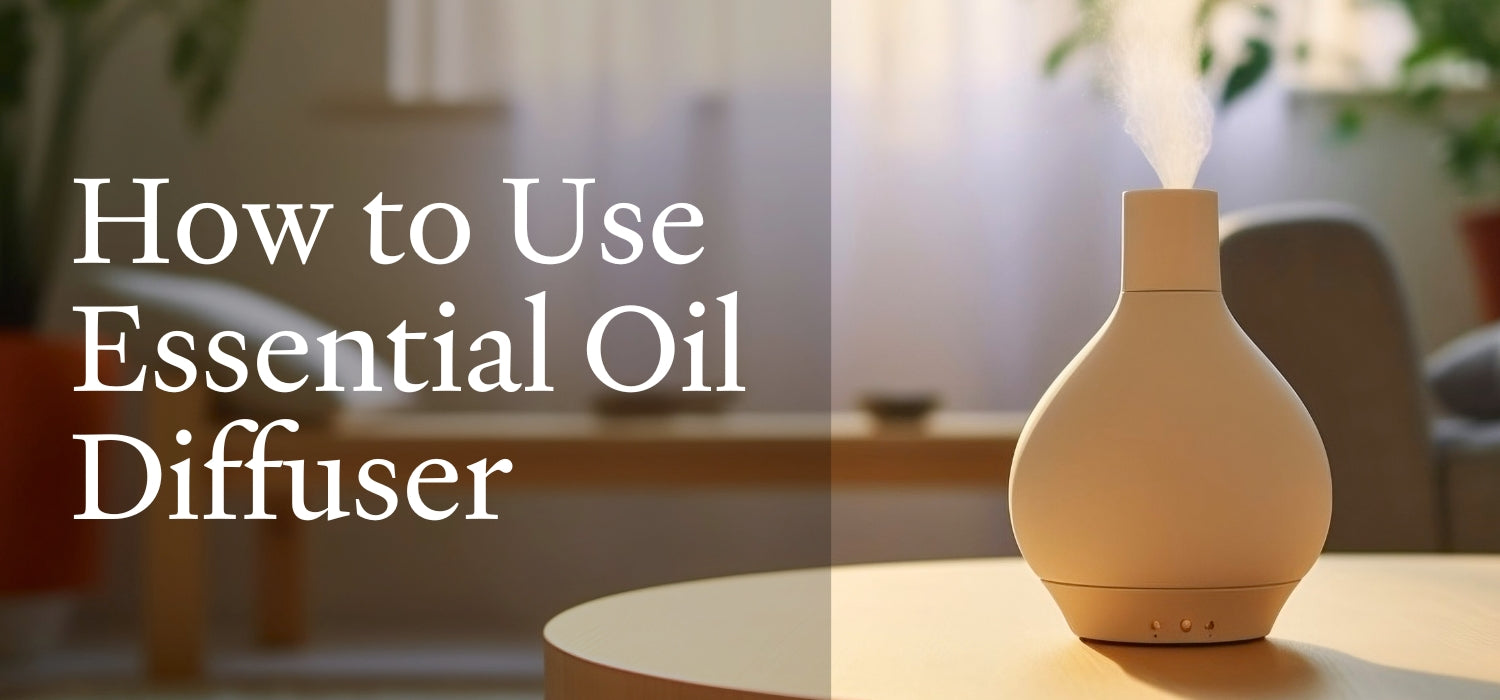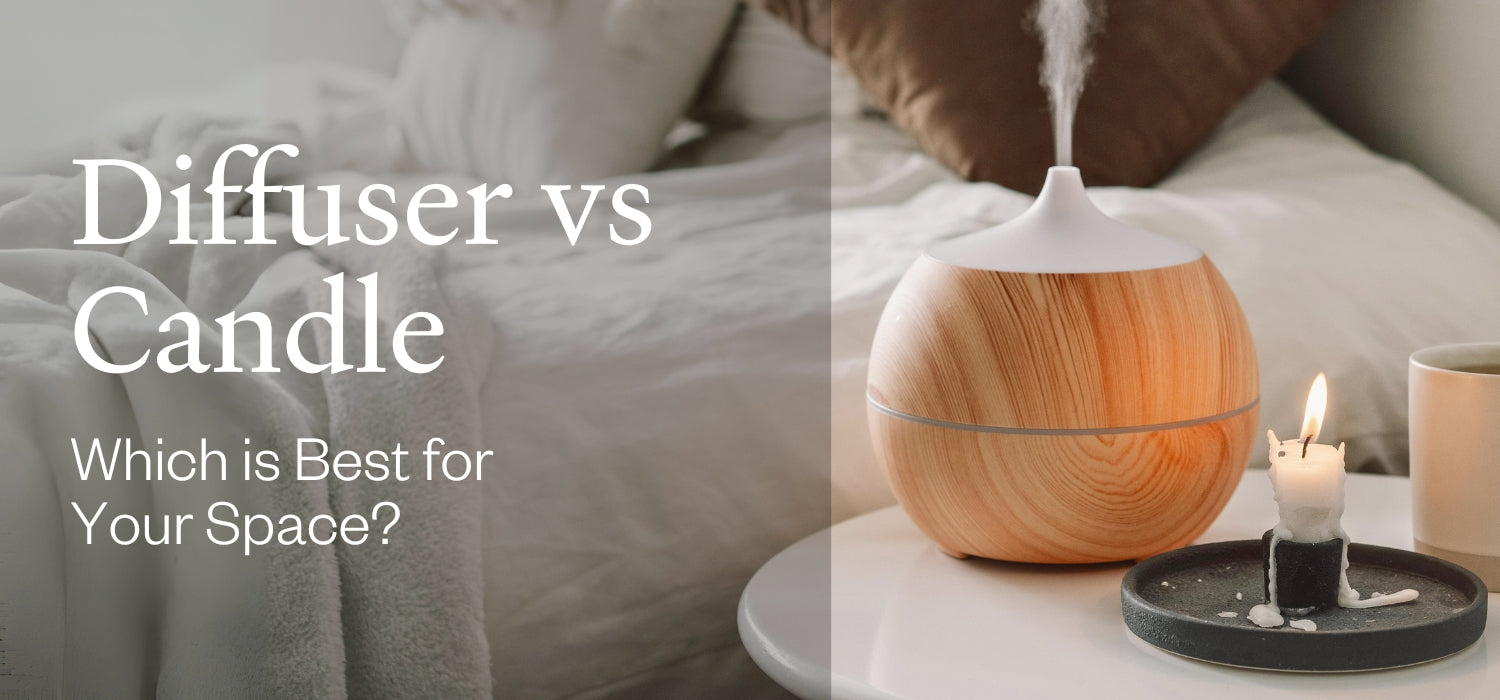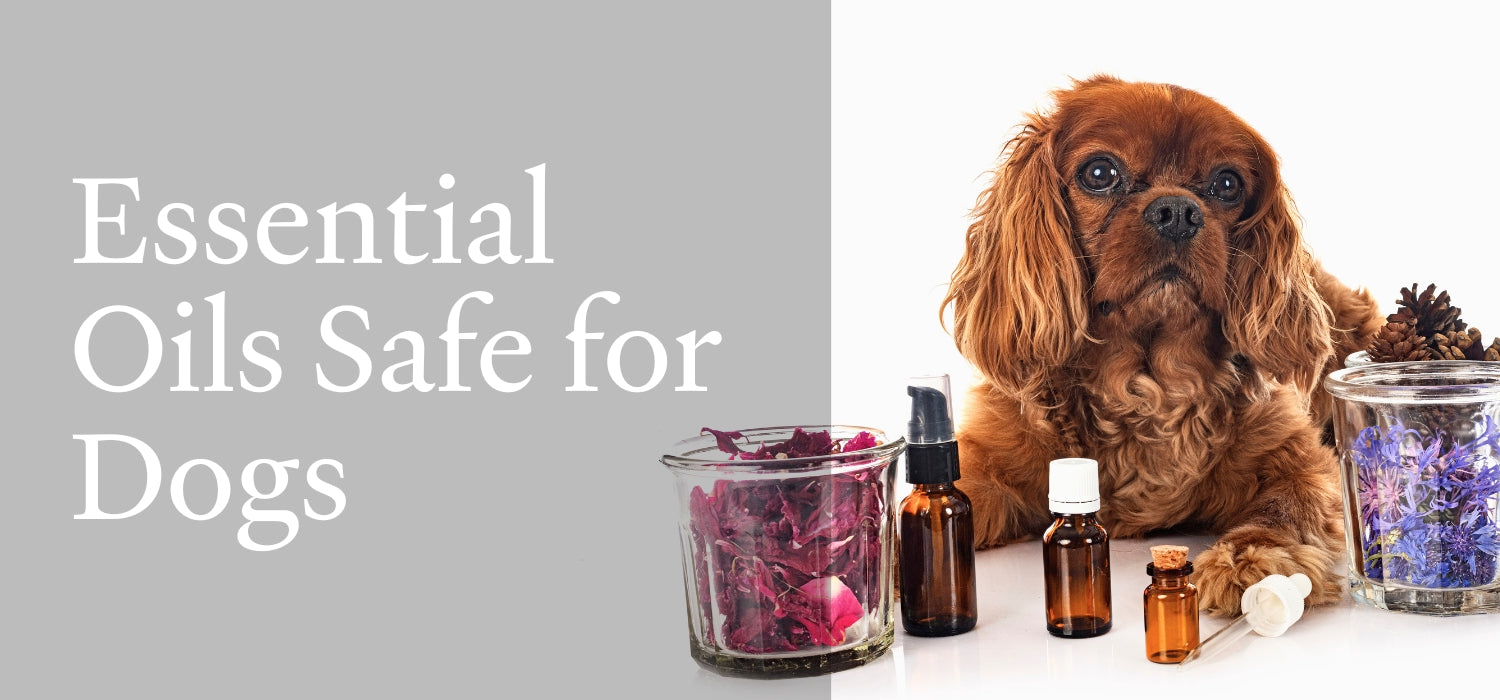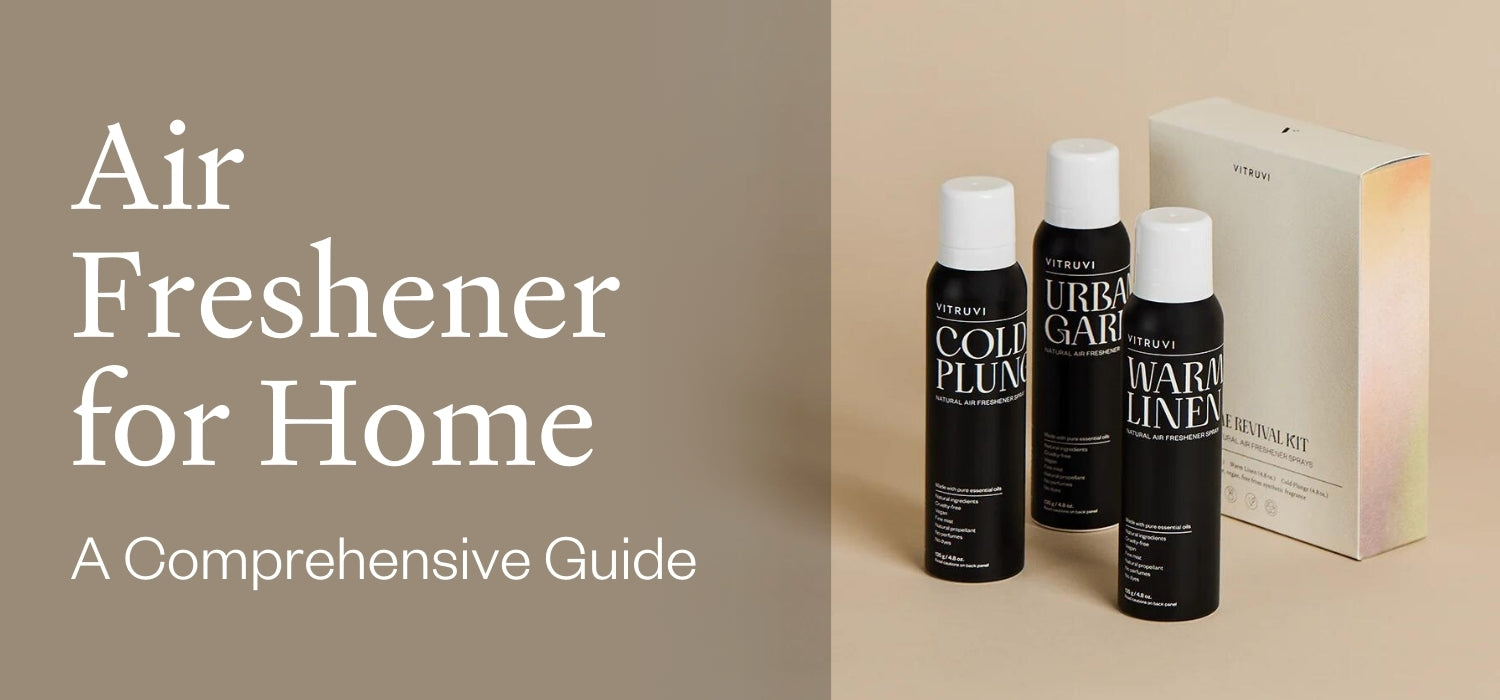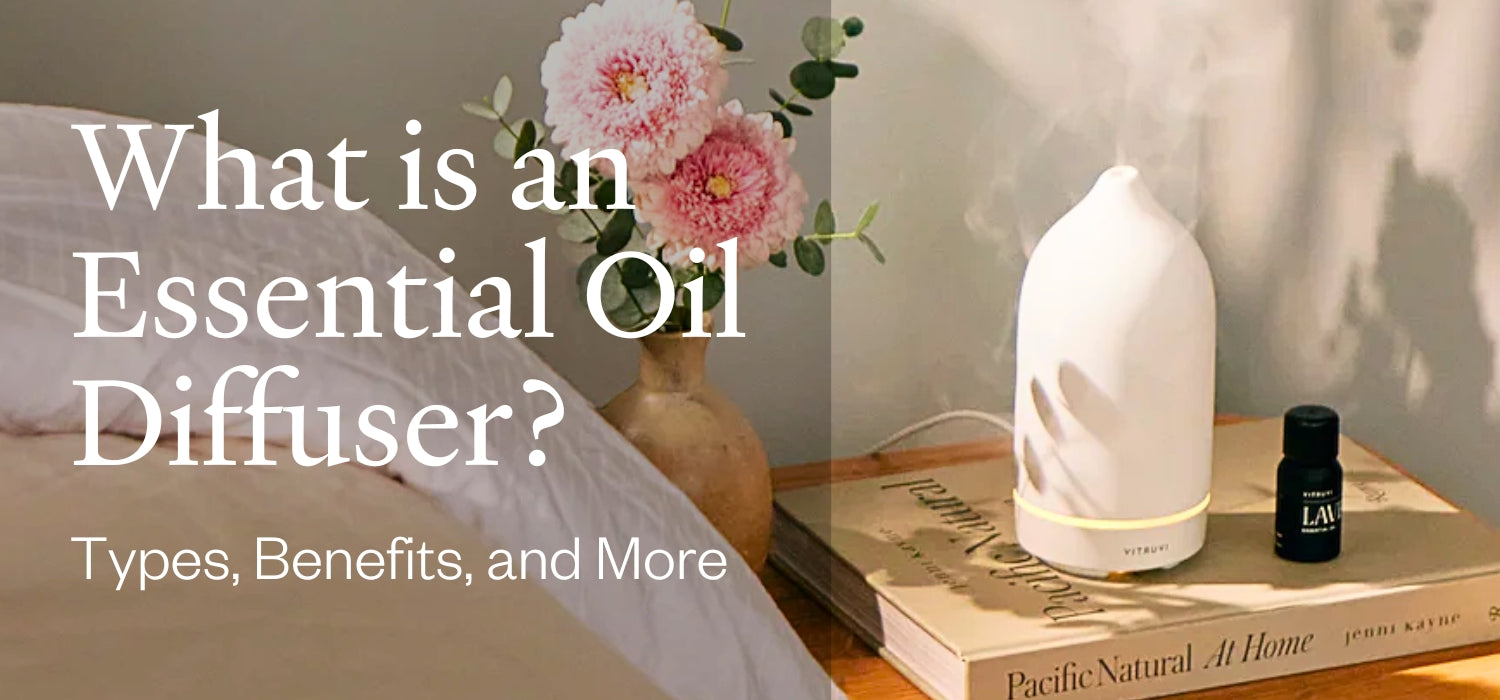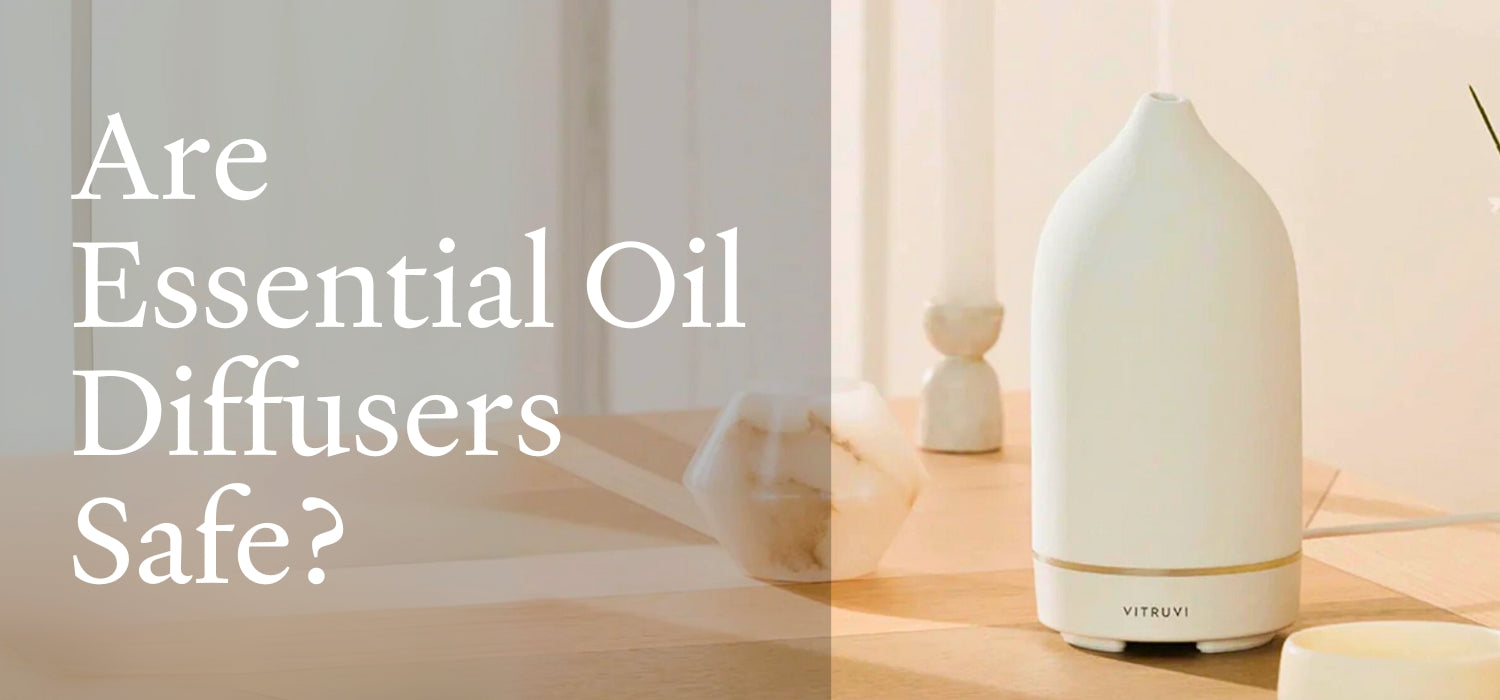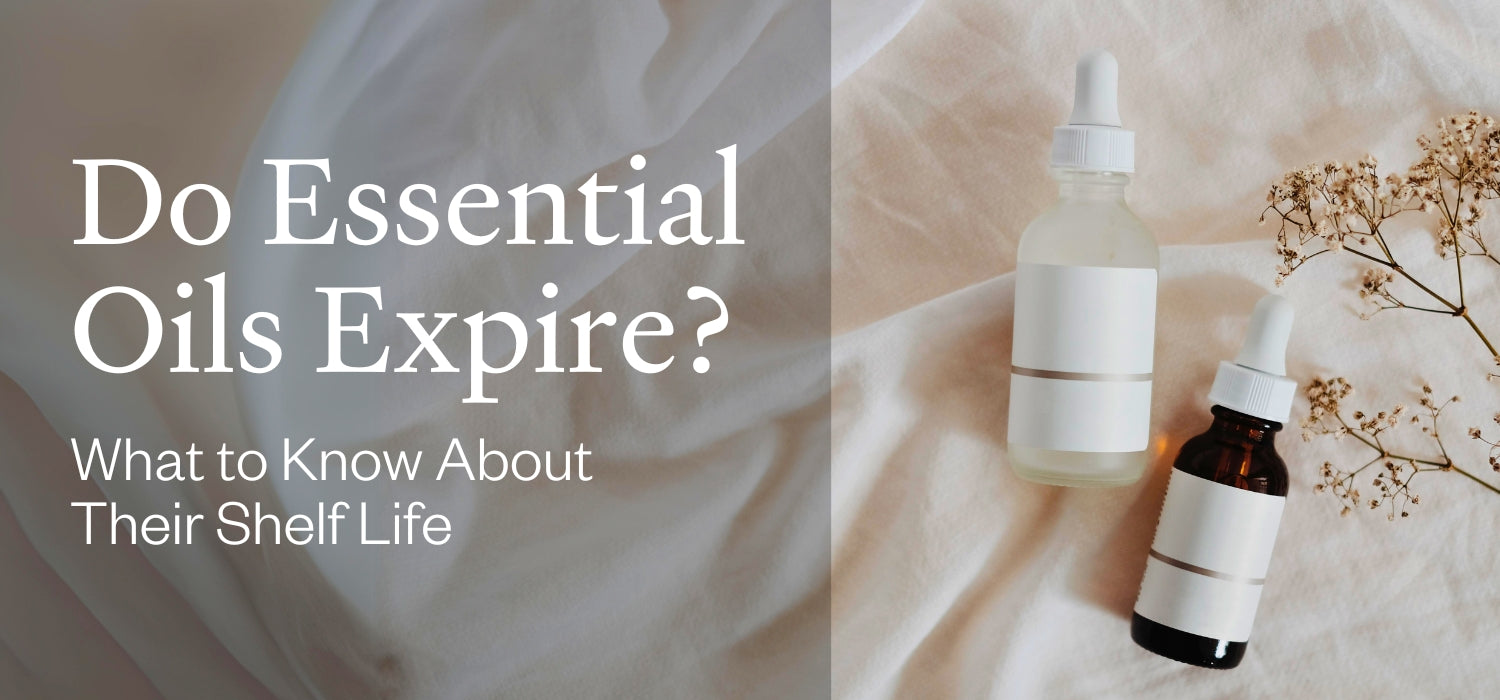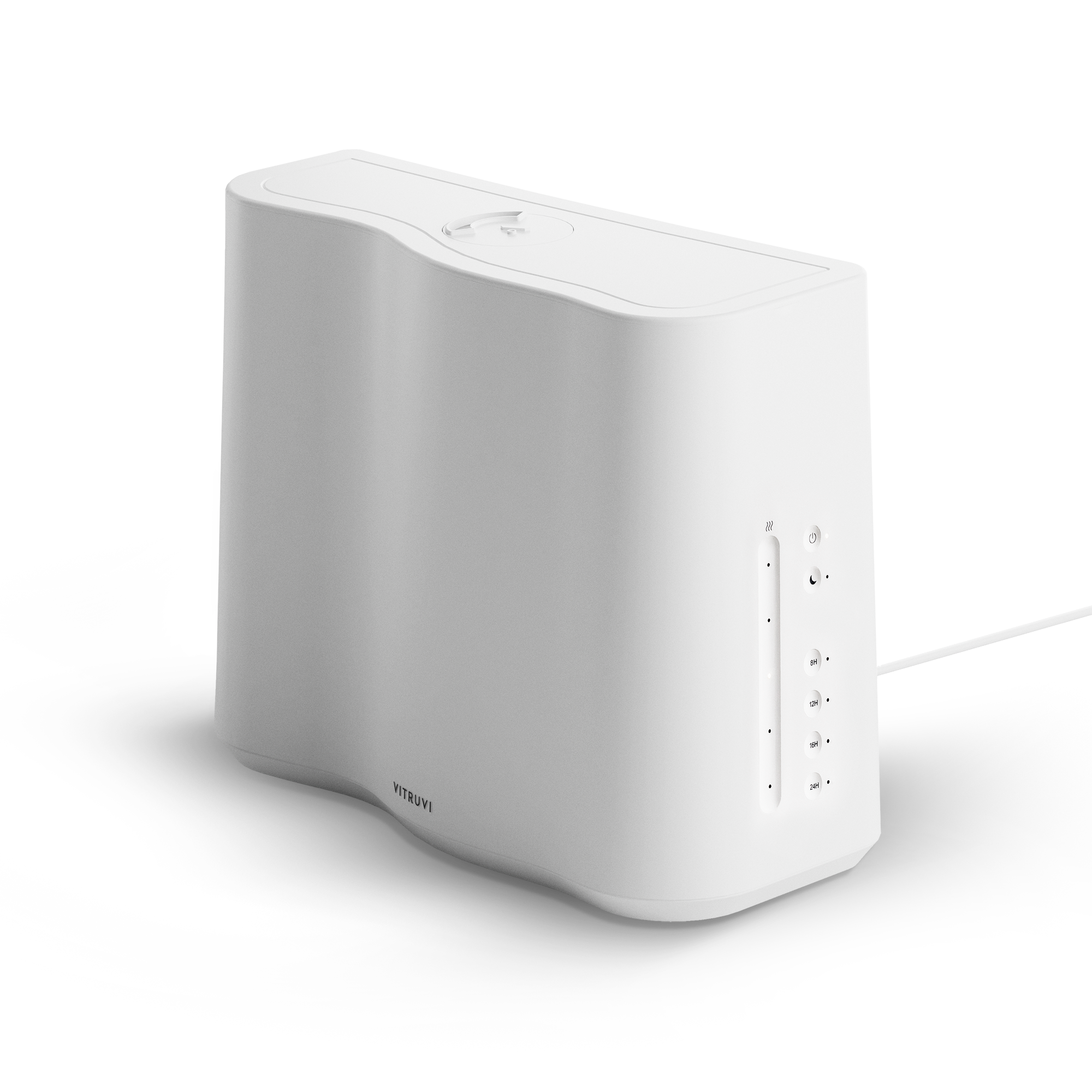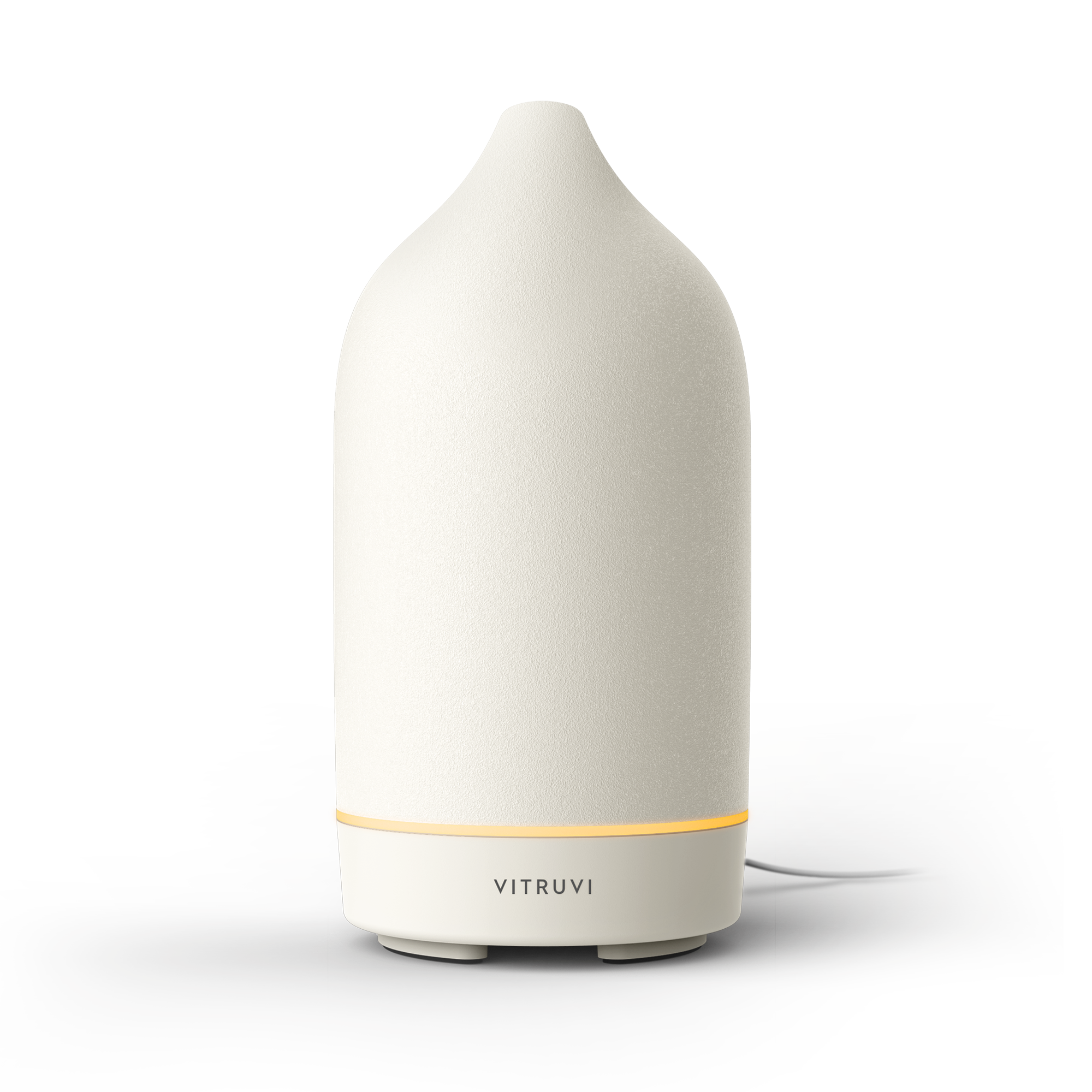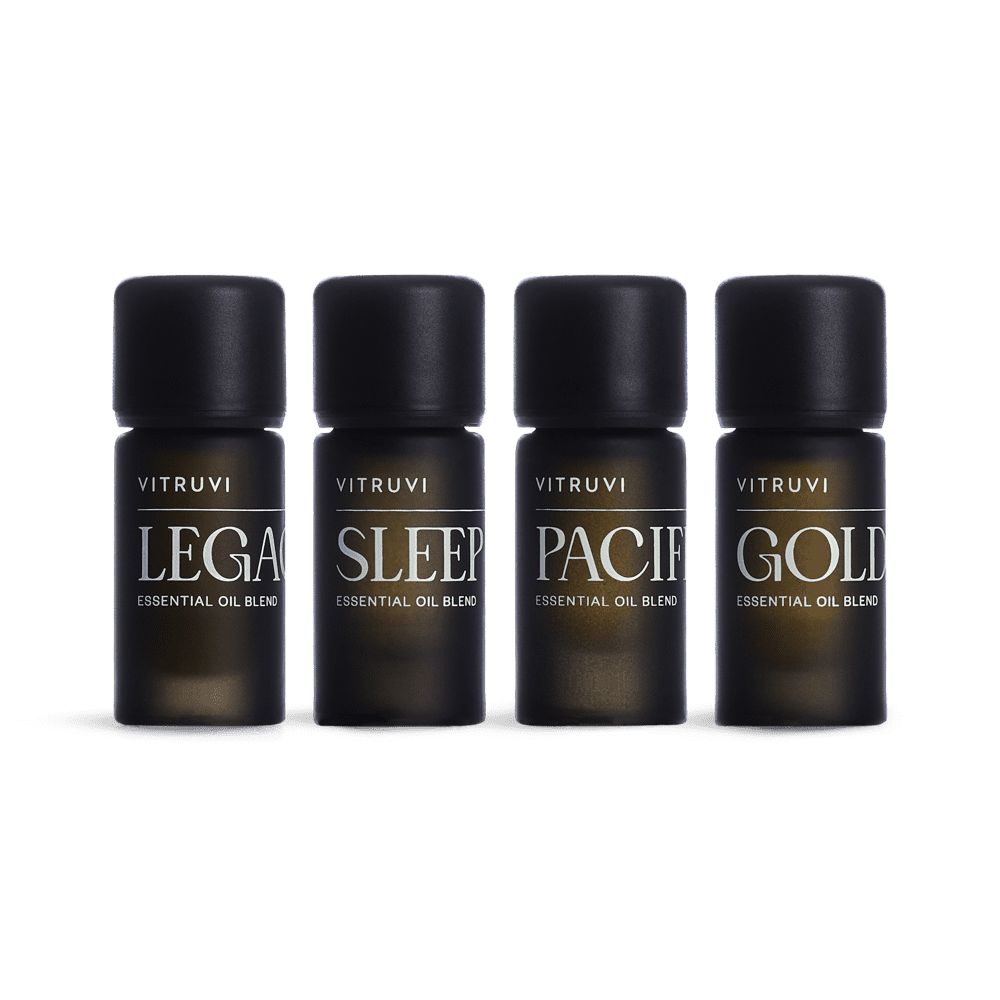Essential oil diffusers work by dispersing essential oils into the air as a light mist. Using one is a simple way to transform your space into a soothing retreat where you can rest and recenter yourself.
Here is a quick look at how to use an essential oil diffuser.
By getting to know these steps in detail and other related tips and information, this guide will ensure you are all set to indulge in the benefits of aromatherapy right in your own space!
Types of Essential Oil Diffusers
There are four main types of essential oil diffusers: ultrasonic, nebulizing, heat, and evaporative.
Each type has a unique way of dispersing essential oils into the air, so choosing the one that best suits your needs and preferences is important.
Ultrasonic Diffusers

Ultrasonic diffusers use high-frequency sound waves to vibrate water and essential oils, creating a fine mist that is dispersed into the air.
These diffusers are silent and double as humidifiers, adding moisture to the air, which is particularly beneficial in dry climates or during the winter.
Ultrasonic diffusers are the most popular type because they are quiet, easy to use, and relatively affordable.
Nebulizing Diffusers
Nebulizing diffusers are often considered the most powerful type of essential oil diffuser.
This diffuser type breaks down essential oils into very fine particles using a stream of compressed air. This method preserves the therapeutic properties of the oils more effectively than other types of diffusers.
Nebulizing diffusers are ideal for those seeking a strong and concentrated aroma.
They are particularly effective in larger spaces and for those who want to experience the full therapeutic benefits of their essential oils.
Heat Diffusers
Heat diffusers use gentle heat to evaporate essential oils into the air. They are often more affordable and can be a simple way to enjoy aromatherapy at home.
However, they can alter the therapeutic properties of some essential oils and, if not used properly, may be a fire hazard.
Evaporative Diffusers
Evaporative diffusers use airflow to evaporate essential oils.
These can be as simple as a fan diffuser or as natural as reed diffusers, where the essential oils travel up the reeds and evaporate into the air.
Evaporative diffusers are quiet, portable, and ideal for use in smaller spaces or when you need a quick burst of aroma.
Step-by-Step Guide: How to Use an Essential Oil Diffuser

Using an essential oil diffuser is simple, but following the correct steps ensures you get the most out of your device and oils.
Here is a straightforward guide on how to use a diffuser.
Step 1: Prepare Your Diffuser
First, find a stable surface in your room where you want to enjoy the benefits of your diffuser. Make sure it is near a power outlet but away from anything that could be damaged by water or oil.
Avoid placing it near electronics or air vents, affecting the mist's dispersal.
Giving your diffuser a quick wipe down with a damp cloth before use is a good idea, especially if it has been sitting unused for a while.
Step 2: Add Water
Next, open your diffuser’s water reservoir and fill it with clean, room-temperature water to the indicated fill line.
Avoid using too much or too little water, which can affect the effectiveness of your diffuser. Water is key because it helps to disperse the essential oils evenly into the air.
Remember, it is not about filling the whole room with mist but about creating a subtle, calming atmosphere.
Pro Tip: Distilled or filtered water helps prevent the buildup of white dust from tap water.
Step 3: Add Essential Oils
Depending on the size of your diffuser, add 5-10 drops of your favorite oil or blend.
This is where you get to customize your experience—whether in the mood for something calming like lavender or energizing like peppermint.
Do not be afraid to experiment with combinations until you find what works best for you.
Step 4: Turn On the Diffuser and Enjoy
With everything in place, it is time to turn on your diffuser.
Most models have simple settings that allow you to adjust the mist intensity, set a timer, or even choose a light option. If your diffuser has these features, take a moment to customize it to your liking.
As the diffuser begins to work, you will notice the aroma of the essential oils filling the room.
Sit back, relax, and enjoy the benefits of aromatherapy.
Step 5: Clean the Diffuser After Use
After you are done using the diffuser, it is important to clean it to keep it running smoothly.
Start by emptying any remaining water and oils, then wipe the inside with a soft cloth. For a deeper clean, use vinegar and water to remove any residue.
Regular cleaning not only prolongs the life of your diffuser but also ensures that you get the purest scent each time you use it.
Best Practices for Using Essential Oils with Your Diffuser
To get the most out of your essential oil diffuser, it is important to use high-quality oils and follow some best practices.
Here are the best practices when using an essential oil diffuser.
1. Choose High-Quality Essential Oils
Invest in high-quality oils from reputable brands. Look for oils that are 100% pure, therapeutic grade, and free from synthetic additives.
When you are new to essential oils, it is best to start with a single oil and see how it affects you.
Once familiar with its effects, you can experiment with blending different oils.
Different essential oils have different properties and benefits. Choose oils based on your desired outcome—relaxation, stress relief, or improved mood.
2. Proper Dilution and Blending Practices
Dilution is vital when using essential oils. Most diffusers require you to add water along with the oil, which helps distribute the aroma more evenly.
If you are blending essential oils, experiment with different combinations to create a personalized scent.
Start with 1-2 drops of each oil and adjust according to your preference.
When applying oils topically, always dilute the essential oil with a carrier oil like coconut, almond, or jojoba oil.
3. Safety Precautions
While essential oils are natural, they are potent and should be used carefully.
Remember these safety precautions to ensure your experience with essential oils diffusers is safe and effective.
- Avoid Overuse.
Adding more oil for a stronger scent could be tempting, but overdoing it can lead to irritation or headaches. Stick to the recommended number of drops.
- Proper Ventilation
Always use your diffuser in a well-ventilated area to prevent the build-up of essential oils in the air.
- Allergy Considerations
If you are using a new essential oil, it is wise to first test for allergic reactions by diffusing a small amount.
- Pet and Child Safety
Some essential oils can cause sensitivities in pets and young children. Place essential oil bottles in a locked cabinet or drawer that is out of reach of pets and children. Never leave children unsupervised around a running diffuser.
Troubleshooting Common Essential Oil Diffuser Issues
Knowing how to use an essential oil diffuser safely also means being prepared to troubleshoot common issues that might arise.
Here are some common issues and how to address them.
- The diffuser is not misting.
If your diffuser is not producing mist, the first thing to check is the water level. Ensure that it is filled up to the appropriate level.
If that does not work, try cleaning the diffuser, as residue build-up can block the misting function.
- The oils are not diffusing properly.
Sometimes, you may notice that the scent of your essential oils is not as strong as expected. This could be due to using too little oil, poor quality oils, or even over-dilution.
Make sure you are using the correct number of drops and that your oils are pure and fresh.
- The diffuser is making unusual noises.
A slight hum is normal, but if your diffuser makes loud or unusual noises, it could be due to debris or water levels.
Turn off the diffuser, empty it, and give it a thorough clean.
If the noise persists, check if the diffuser is placed on a stable surface and not vibrating against anything.
- The diffuser is leaking.
If you notice water leaking, check that the diffuser is properly assembled and that all parts are securely in place.
Inspect the diffuser for cracks or damage. Make sure it is on a level surface, and avoid overfilling the water reservoir.
- The diffuser is not turning on.
Check the power source and ensure the diffuser is plugged in. Also, inspect the power cord for any damage.
If the diffuser still does not turn on, try resetting it by unplugging it for a few minutes and then plugging it back in.
You could also try cleaning the sensor or the power button to ensure it is not blocked by residue or scale.
Benefits of Using an Essential Oil Diffuser
Adding an essential oil diffuser to your daily routine can bring a range of benefits for both your mind and body.
Here are some of the top advantages you can enjoy.
Stress Relief
Essential oils like lavender, chamomile, and eucalyptus have soothing scents that can help reduce stress and promote relaxation, making them perfect for unwinding after a long day.
Improved Sleep
Diffusing calming oils before bedtime can improve sleep quality, helping you fall asleep faster and longer. Oils like lavender and sandalwood are particularly effective for this.
Enhanced Mood
Feeling a bit low? Citrus oils like lemon, orange, and grapefruit can boost mood and increase energy levels.
Better Air Quality
Diffusing essential oils can help clean the air in your home. They help purify your space by eliminating harmful bacteria.
Enhanced Focus and Concentration
Need to focus? Diffuse rosemary or peppermint for a mental boost. These scents can help sharpen your mind and keep you on task.
Frequently Asked Questions (FAQs)
This section addresses additional concerns related to the use of an essential oil diffuser.
Can I Leave My Diffuser on All Night?
Yes, you can leave your diffuser on overnight. Vitruvi diffusers are designed with safety features like automatic shut-off when the water runs low or when a timer is set. They also include soothing light options that create a calm, relaxing atmosphere, perfect for sleep.
Just be sure to follow the manufacturer’s instructions.
How Do I Clean My Essential Oil Diffuser?
To clean your essential oil diffuser, fill it halfway with plain water and add a teaspoon of white vinegar. Run the diffuser for 5-10 minutes to allow the vinegar to disperse through all components, then empty the reservoir and wipe it clean.
Note: If you want to avoid vinegar or do not have any, you can clean your diffuser by wiping the inside with a damp cloth. Doing this once a week will keep it fresh.
How Often Should I Change the Oil in My Diffuser?
If you use your diffuser daily with the same oil or blend, it is best to clean and change the oil once a week.
This helps prevent build-up and ensures your diffuser stays fresh and mold-free. Regular cleaning also keeps your diffuser working effectively.
If you notice a faint scent lingering even after cleaning, it might be time for deep cleaning (check the FAQ above).
Key Takeaways on How to Use Essential Oil Diffusers
Diffusers are a fantastic way to incorporate the power of essential oils into your daily life. They are easy to use, require minimal maintenance, and benefit your well-being.
To wrap up, here are the most critical points to remember when using an essential oil diffuser.
- Understand the different types of diffusers—ultrasonic, nebulizing, heat, and evaporative—to select the one that best suits your needs.
- Follow Proper Usage Steps. Prepare, add water, use quality oils, and clean regularly.
- Diffuse Safely. Use the right amount of oil, ensure good ventilation, and remember safety, especially with pets and kids.
- Troubleshoot. If your diffuser is not working correctly, simple steps like adjusting the water level or cleaning the device can often resolve the problem.
- Enjoy the benefits. From stress relief to cleaner air, diffusers can improve your home and well-being.
With this guide and a little practice, you will master your essential oil diffuser and enjoy all its benefits.
So, take a deep breath, relax, and let the soothing scents transform your space!

